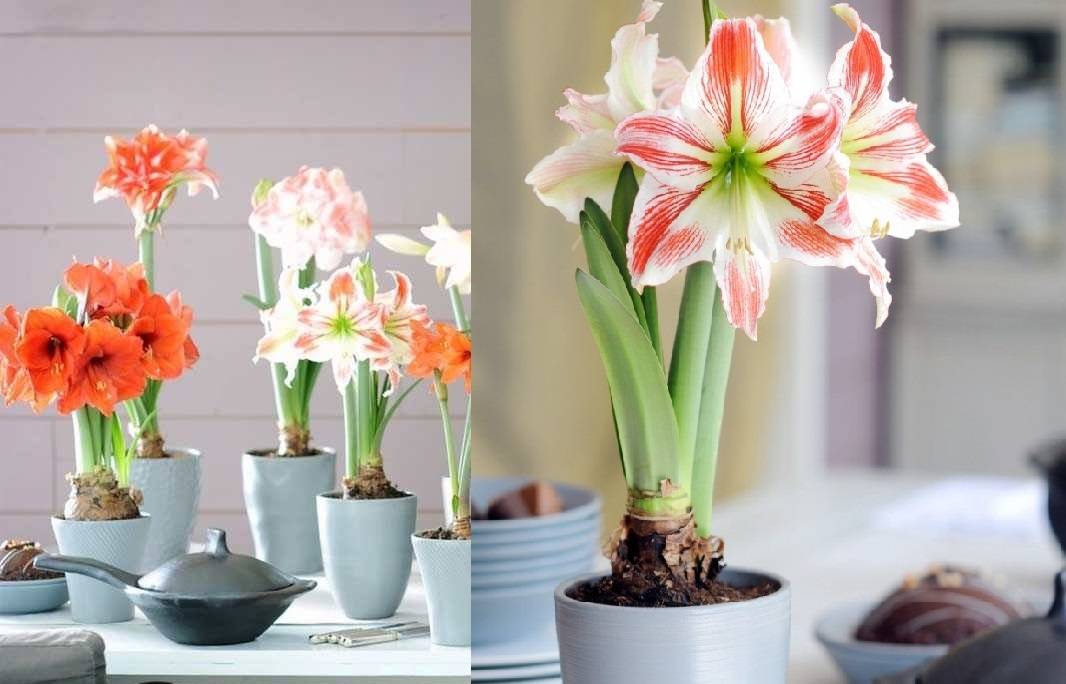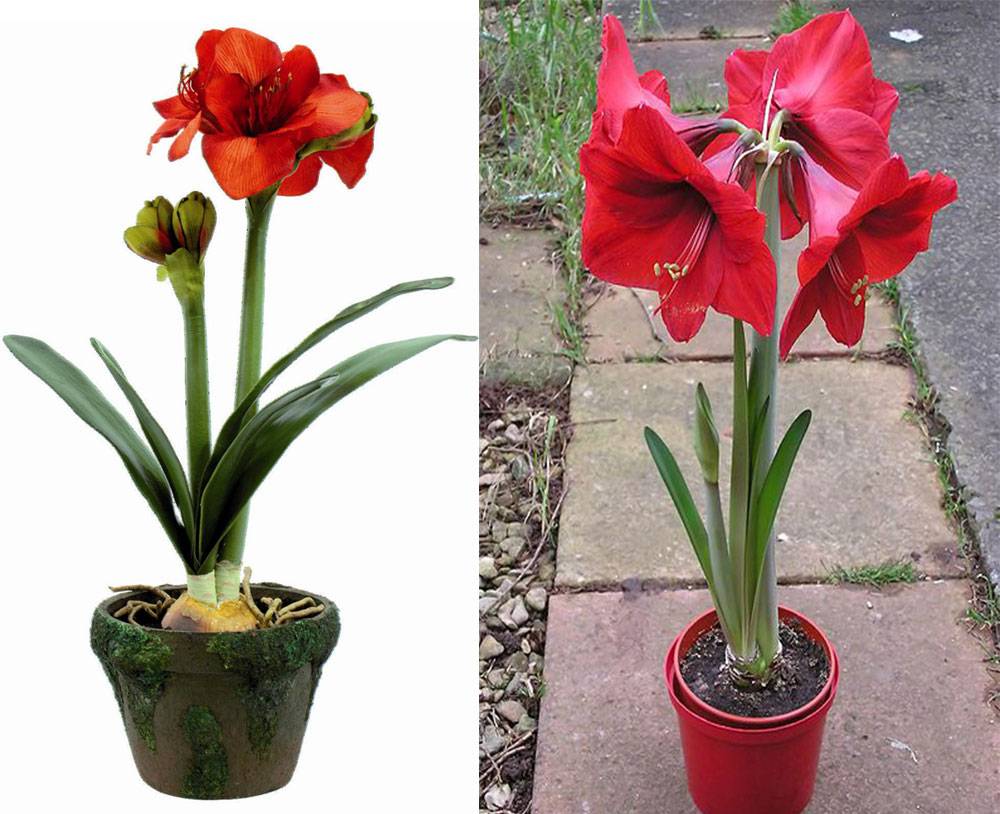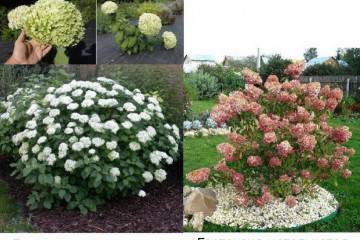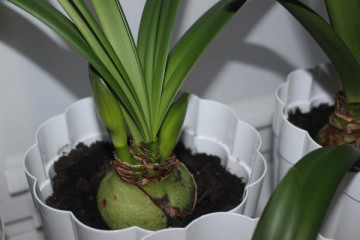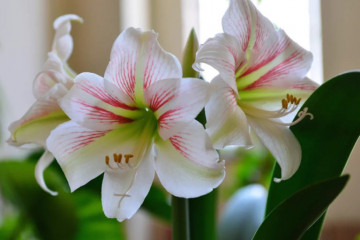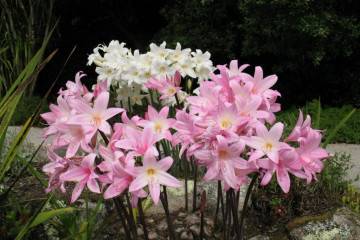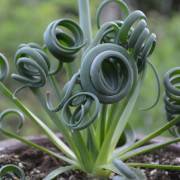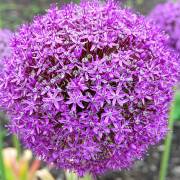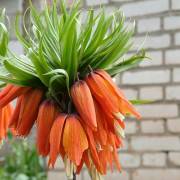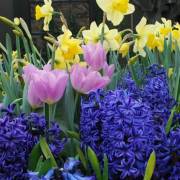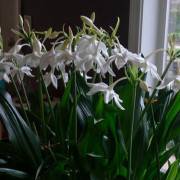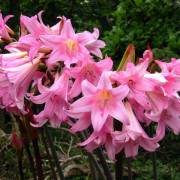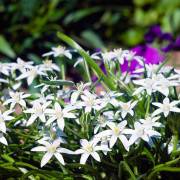Amaryllis and hippeastrum - differences, what is the difference
Content:
Surprisingly, not all experienced florists at first glance can tell the difference between two popular indoor flowers - amaryllis and hippeastrum. What to say about newcomers who have not dealt with such plants before. However, it is still worthwhile to accurately determine the name of the flower, since the care of the species is different.
The main differences between amaryllis and hippeastrum
To understand how amaryllis differs from hippeastrum, you first need to understand the botanical description of plants. Despite the external similarity, they have certain differences in structure.
Differences between hippeastrum and amaryllis:
- has a little more than 90 varieties, and only one amaryllis;
- the difference in the bulbs: in the hippeastrum it is elongated and in its shape is very similar to a light bulb or a pear with pubescent scales, in amaryllis it is round in shape with smooth hairless scales;
- Amaryllis has more abundant flowering - up to 13 flowers on a bush, in another flower there are half, or even three times less;
- the peduncle of the hippeastrum is empty or hollow inside, while in the amaryllis, on the contrary, it is dense in structure;
- the leaf plates of the hippeastrum are wider and appear in the same period together with the peduncle, and in the amaryllis, the leaves are fully formed after flowering;
- hippeastrum blooms towards the end of winter or spring, while in amaryllis it occurs in the autumn or in the very last days of August;
- another difference that will help you easily distinguish flowers is the presence of a smell: if the aroma is present, then it is definitely amaryllis, hippeastrum does not smell at all.
The difference in the species diversity of colors
Although the plants are classified in the same family, called the Amaryllidaceae, they are subdivided into different genera. Amaryllis has one species of the same name, while there are almost 100 varieties in the genus hippeastrum. Moreover, there are many hybrid varieties of hippeastrum that have been bred by breeders.
The origin of plants
The spread of amaryllis around the world began in South Africa. Hippeastrum used to grow only in the Amazonian humid forests on the American continent. Both plants were exported to Europe, where they began to be cultivated at home.
Both flowers appeared on the European continent almost simultaneously, so they were classified as one species and called lilies. At first, no one guessed that these were two flowers completely different in botanical origin.
Crossbreeding ability
Hippeastrum is generally difficult to give in to this procedure; in almost 90% of cases, the flower does not have the ability to interbreed with other varieties and species of its group. But belladonna calmly tolerates this process, it lends itself especially well to crossing with nerina or brunswigia.
Flowering periods
Hippeastrum from amaryllis is distinguished by the period and duration of flowering. This distinction is, of course, not a visual distinction and will not help when purchasing a plant. However, if friends have such a plant and the exact name is not known, you can simply follow the time at which the flower begins to form buds.
Hippeastrum blooms early, already in the second half of winter, the indoor flower opens its buds. This process usually takes place from February to May. Until the end of the season, flowering can occur 2-3 more times with short interruptions. But during wintering, from November to February, the bush rests and does not release buds.
Home interior flower amaryllis blooms for the first time in a season only with the approach of autumn. This process continues until the plant leaves the dormant stage. But the flowering at the bush is much more abundant, in one process up to 12-13 inflorescences can bloom.
Appearance, color and shape of flowers, leaves
It is possible to distinguish belladonna - a flower similar to hippeastrum, visually, that is, by comparing the external characteristics. Amaryllis grows to about 50-60 cm in height, while in the hippeastrum the average length is much longer, it ranges from 80 cm to 1 m.
Each stem of the hippeastrum has two leaves at the very base, another additional one grows specially to hold large inflorescences. Belladonna stems are single, on the top of which are inflorescences.
Amaryllis, after flowering, often begins to lose its foliage. There is nothing to worry about, since this behavior is quite typical for a flower. The flowers are in the shape of a funnel-shaped bowl and include 6 petals of the same size. Their colors come in various shades: pink, lilac, lilac, purple.
In the hippeastrum, only 3 to 6 inflorescences appear. The shape, size and color of the buds completely depend on the type and variety of the plant. Like belladonna, a common and common shape is a funnel-shaped bowl. But the colors of the inflorescences are much more diverse than that of belladonna, there are about 2000 different colors.
The leaf plates are also slightly different. In hippeastrum, they are belt-shaped and wide, and in amaryllis, the xiphoid leaves are much thinner.
How not to be confused when buying
When purchasing bulbs for planting, be sure to pay attention to their shape. In the hippeastrum, it is pear-shaped, and scales with hairy pubescence are located on the surface. If the bulb is smooth and round, then belladonna will grow out of it.
If you are buying an adult flowering plant, then you should pay attention to the presence of leaf plates. If they are present in a flowering bush, then it is amaryllis. You should also pay attention to the size of the buds, in the hippeastrum they are usually slightly larger.
It also does not interfere with sniffing the flowers, because unlike the pleasantly smelling amaryllis, hippeastrum has no smell.
Experienced growers advise to try to tear off one plate on the bulbs of plants when buying. If an area is visible under it, as if covered with cobwebs, then this plant is an amaryllis.
If we compare the botanical descriptions of amaryllis and hippeastrum flowers, the differences are quite significant. However, only botanists and scientists pay attention to this. For ordinary gardeners, there is no special need to distinguish both plants, their similarity is only a plus, because they bloom beautifully and do not require special care. Is that the flowering of amaryllis is more abundant, but the hippeastrum has larger leaf plates.
